AMD A10-5800K & A8-5600K Review: Trinity on the Desktop, Part 1
by Anand Lal Shimpi on September 27, 2012 12:00 AM ESTAfter years of waiting, AMD finally unveiled its Llano APU platform fifteen months ago. The APU promise was a new world where CPUs and GPUs would live in harmony on a single, monolithic die. Delivering the best of two very different computing architectures would hopefully pave the way for a completely new class of applications. That future is still distant, but today we're at least at the point where you can pretty much take for granted that if you buy a modern CPU it's going to ship with a GPU attached to it.
Four months ago AMD took the wraps off of its new Trinity APU: a 32nm SoC with up to four Piledriver cores and a Cayman based GPU. Given AMD's new mobile-first focus, Trinity launched as a notebook platform. The desktop PC market is far from dead, just deprioritized. Today we have the first half of the Trinity desktop launch. Widespread APU availability won't be until next month, but AMD gave us the green light to begin sharing some details including GPU performance starting today.
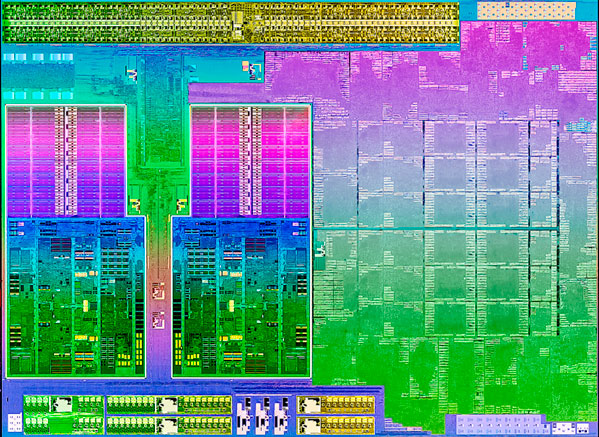
AMD's Trinity APU, 2 Piledriver modules (4 cores)
We've already gone over the Trinity APU architecture in our notebook post earlier this year. As a recap, Piledriver helped get Bulldozer's power consumption under control, while the Cayman GPU's VLIW4 architecture improved efficiency on the graphics side. Compared to Llano this is a fairly big departure with fairly different CPU and GPU architectures. Given that we're still talking about the same 32nm process node, there's not a huge amount of room for performance improvements without ballooning die area but through architecture changes and some more transistors AMD was able to deliver something distinctly faster.
| Trinity Physical Comparison | |||||
| Manufacturing Process | Die Size | Transistor Count | |||
| AMD Llano | 32nm | 228mm2 | 1.178B | ||
| AMD Trinity | 32nm | 246mm2 | 1.303B | ||
| Intel Sandy Bridge (4C) | 32nm | 216mm2 | 1.16B | ||
| Intel Ivy Bridge (4C) | 22nm | 160mm2 | 1.4B | ||
On the desktop Trinity gets the benefit of much higher TDPs and thus higher clock speeds. The full lineup, sans pricing, is below:
Remember the CPU cores we're counting here are integer cores, FP resources are shared between every two cores. Clock speeds are obviously higher compared to Llano, but Bulldozer/Piledriver did see some IPC regression compared to the earlier core design. You'll notice a decrease in GPU cores compared to Llano as well (384 vs. 400 for the top end part), but core efficiency should be much higher in Trinity.
Again AMD isn't talking pricing today, other than to say that it expects Trinity APUs to be priced similarly to Intel's Core i3 parts. Looking at Intel's price list that gives AMD a range of up to $134. We'll find out more on October 2nd, but for now the specs will have to be enough.
Socket-FM2 & A85X Chipset
The desktop Trinity APUs plug into a new socket: FM2. To reassure early adopters of Llano's Socket-FM1 that they won't get burned again, AMD is committing to one more generation beyond Trinity for the FM2 platform.
The FM2 socket itself is very similar to FM1, but keyed differently so there's no danger of embarrassingly plugging a Llano into your new FM2 motherboard.
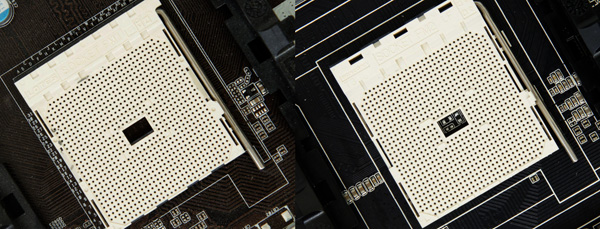
Socket-FM1 (left) vs. Socket-FM2 (Right)
AMD both borrows from Llano as well as expands when it comes to FM2 chipset support. The A55 and A75 chipsets make another appearance here on new FM2 motherboards, but they're joined by a new high-end option: the A85X chipset.
The big differentiators are the number of 6Gbps SATA and USB 3.0 ports. On the A85X you also get the ability to support two discrete AMD GPUs in CrossFire although obviously there's a fairly competent GPU on the Trinity APU die itself.
The Terms of Engagement
As I mentioned earlier, AMD is letting us go live with some Trinity data earlier than its official launch. The only stipulation? Today's preview can only focus on GPU performance. We can't talk about pricing, overclocking and aren't allowed to show any x86 CPU performance either. Obviously x86 CPU performance hasn't been a major focus of AMD's as of late, it's understandable that AMD would want to put its best foot forward for these early previews. Internally AMD is also concerned that that any advantages it may have in the GPU department are overshadowed by their x86 story. AMD's recent re-hire of Jim Keller was designed to help address the company's long-term CPU roadmap, however until then AMD is still in the difficult position of trying to sell a great GPU attached to a bunch of CPU cores that don't land at the top of the x86 performance charts.
It's a bold move by AMD, to tie a partial NDA to only representing certain results. We've seen embargoes like this in the past, allowing only a subset of tests to be used in a preview. AMD had no influence on what specifics benchmarks we chose, just that we limit the first part of our review to looking at the GPU alone. Honestly with some of the other stuff we're working on I don't mind so much as I wouldn't be able to have a full review ready for you today anyway. Our hands are tied, so what we've got here is the first part of a two part look at the desktop Trinity APU. If you want to get some idea of Trinity CPU performance feel free to check out our review of the notebook APU. You won't get a perfect idea of how Piledriver does against Ivy Bridge on the desktop, but you'll have some clue. From my perspective, Piledriver seemed more about getting power under control - Steamroller on the other hand appears to address more on the performance side.
We'll get to the rest of the story on October 2nd, but until then we're left with the not insignificant task of analyzing the performance of the graphics side of AMD's Trinity APU on the desktop.
The Motherboard
AMD sent over a Gigabyte GA-F2A85X-UP4 motherboard along with an A10-5800K and A8-5600K. The board worked flawlessly in our testing, and it also gave us access to AMD's new memory profiles. A while ago AMD partnered up with Patriot to bring AMD branded memory to market. AMD's Performance line of memory includes support for AMD's memory profiles, which lets you automatically set frequency, voltage and timings with a single BIOS setting.
We've always done these processor graphics performance comparisons using DDR3-1866, so there's no difference for this review. The only change is we only had to set a single option to configure the platform for stable 1866MHz operation.
Processor graphics performance scales really well with additional memory bandwidth, making this an obvious fit. There's nothing new about memory profiles, this is just something new for AMD's APU platform.


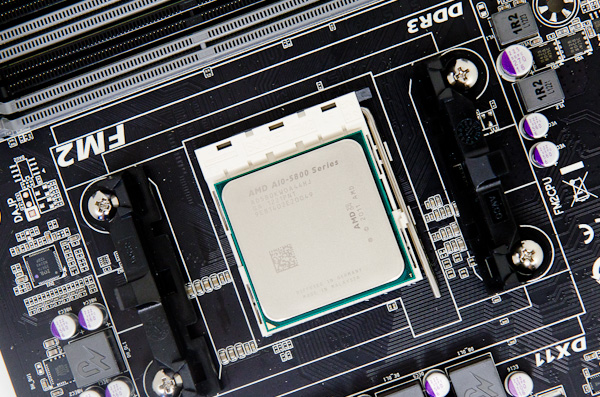
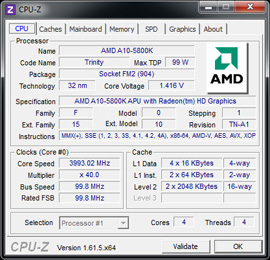
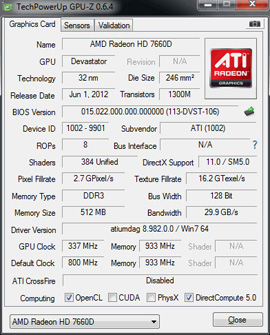
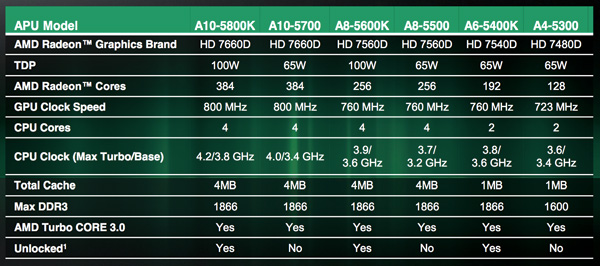

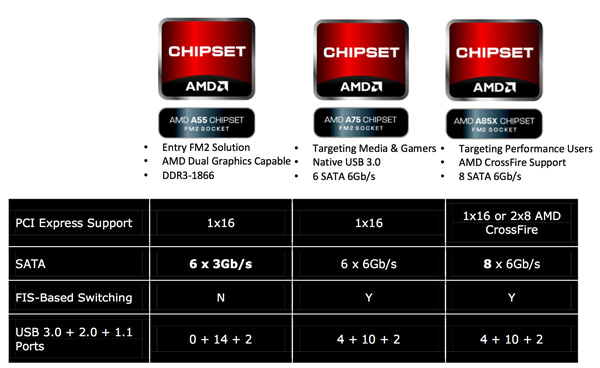






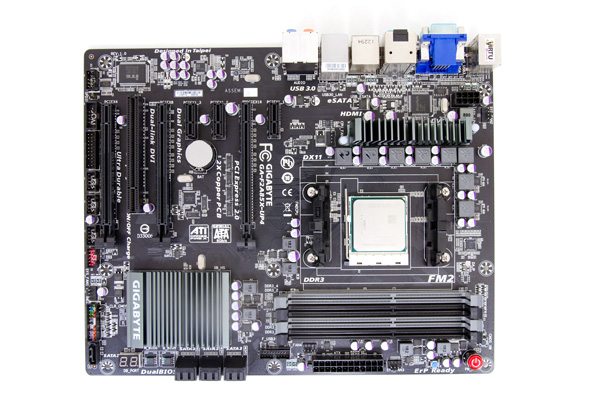

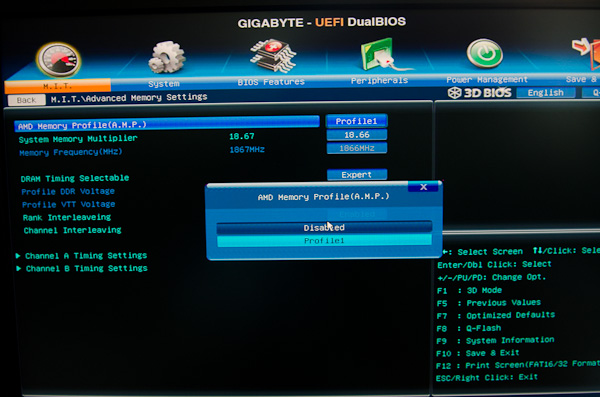








139 Comments
View All Comments
Kougar - Friday, September 28, 2012 - link
Given no mention of a "preview" was mentioned in the title, it would have been nice if the The Terms of Engagement section was at the very top of the "review" to be completely forthright with your readership.I read down to that section and stopped, then went looking through the review for CPU benchmarks which didn't exist. Can thank The Tech Report for posting an editorial on AMD's "preview" clause before I realized what was going on.
Omkar Narkar - Friday, September 28, 2012 - link
would you guys review 5880k crossfired with HD 6670 ???because I've heard that when you pair it with high end GPU like HD7870 then integrated graphics cores doesn't work.
TheJian - Friday, September 28, 2012 - link
Why was this benchmark used in the two reviews before the 660TI launch, and here today, but not in the 660TI article Ryan Smith wrote? This is just more stuff showing bias. He could have easily ran it with the same patch as the two reviews before the 660TI launch article. Is is because in both of those two articles the 600 series dominated the 7970ghz edition and the 7950 Boost? This is at the very least, hard to explain.plonk420 - Monday, October 1, 2012 - link
are those discrete GPUs on the charts being run on the AMD board? or a Sandy/Ivy?seniordady - Monday, October 1, 2012 - link
Please,can you make some test to the CPU vs... not only to the GPU?ericore - Monday, October 1, 2012 - link
http://news.softpedia.com/news/GlobalFoundries-28n...Power leaking reduced by up to 550%; wow.
What an unintended coup for AMD haha all because of Global Foundries.
Take that Intel.
AMD is also first one working on Java GPU acceleration.
shin0bi272 - Tuesday, October 2, 2012 - link
This is cool if you want to game at 13x7 at low res... but who does that anymore? When you bump up games like BF3 or Crysis2 (which you didnt test but toms did) the FPS falls into the single digits. This cpus is fine if you dont really play video games or have a 17" CRT monitor. The thing that I think is funny about this is that in all the games a 100 dollar nvidia gpu beat the living snot out of this apu. Other than HTPC people who want video output without having to buy a video card or someone who doesnt play FPS games but wants to play farmville or minecraft no one will buy this thing. Yet people are still trying to make this thing out to be a gaming cpu/gpu combo and its just not going to satisfy anyone who buys it to play games on and thats disingenuous.Shadowmaster625 - Tuesday, October 2, 2012 - link
When you tested your GT440, you didnt do it on this hardware right? If you were to disable the trinity gpu and put a GT640 in its place, do you think it would still do better? Or would its score be pretty close to that of the iGPU??skgiven - Sunday, October 7, 2012 - link
No idea what the NVidia GT440 is doing there; where are the old AMD alternatives?Given the all to limited review I don't see the point in comparing this to NVidia's discrete GT640.
Firstly, it's not clear if you are comparing the APU's to a DDR3 GT640 version (of which there are two; April 797MHz and June 900MHz) or the GDDR5 version (all 65W TDP).
Secondly, the GT640 has largely been superseded by the GTX650 (64W TDP).
So was your comparison the 612GFlops model, the 691, or 729 GFlops version?
Anyway, the GTX650 is basically the same card but has is rated as 812GFlops (30% faster than the April DDR3 model). Who knows, maybe you intended to add these details along with the GTX650Ti, in a couple of days?
If you are going to compare these APU to discrete entry level cards, you need to add a few more cards. Clearly the A10-5800k falls short against Intels more recent processors for most things (nothing new there), but totally destroys anything Intel has when it comes to gaming, so there is no point in over-analysing that. It wins that battle hands down, so the real question is, how does it perform compared to other gaming APU's and discrete entry level cards?
I'm not sure why you stuck to the same 1366 screen resolution? Can this card not operate at other frequencies, or can the opposition not compete at higher resolutions?
1366 is common for laptops. I don't think these 100W chips are really intended for that market. They are for small desktops, home theatre, entry level (inexpensive) gaming systems.
These look good for basic gaming systems and in terms of performance per $ and Watt, even for some office systems, but their niche is very limited. If you want a good home theatre/desktop/gaming system, throw in a proper discrete GPU and operate at a more sensible 1680 or 1920 for real HD quality.